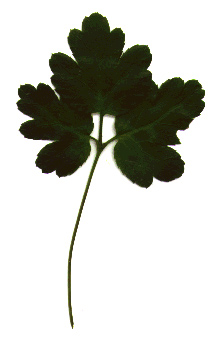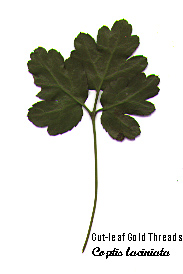 The photo at right
shows cut-leaf gold threads shown in fruit at Table Rock Wilderness Area (BLM),
southeast of Molalla, OR.....7-31-94.
The photo at right
shows cut-leaf gold threads shown in fruit at Table Rock Wilderness Area (BLM),
southeast of Molalla, OR.....7-31-94.
Cut-leaf gold threads is one of those look alike wildflowers that can be easily confused with other species. For myself, I frequently think of it as a member of the parsley family, due to the cleft, ternate or compound pinnate leaves and due to the umbel of seeds when it is in fruit. In particular, its leaves are notably similar to those of the parsley species known as Sanicula. In fact, it is a member of the buttercup family.
Cut-leaf gold threads is a low growing plant with one to several ascending stems from 5-12 cm long at flowering, elongating above the leaves when in fruit. The leaves are basal and either compound ternate or compound pinnate. The larger leaflets range from 2-4 cm long with deeply toothed to parted margins (See photos below.) The upper leaf blade is a dark glossy green, while the lower surface is much lighter. Two to three flowers are found atop the stems The sepals are slenderly lanceolate in shape and 6-10 mm long while the petals are shorter, slender, and with a claw at the base.
Cut-leaf gold threads can be an interesting and somewhat beautiful ground cover in the natural shady garden. Although it flowers very early in the spring, its dark green, glossy leaves are very attractive. It is hardy and seems to withstand competition from wild strawberries very well in my home garden. It probably does better however in a light humus soil than hard clay.
Habitat:
Cut-leaf gold threads lives in moist shady woods at medium elevation in the Coast Range and western slopes of the Cascade Mts of Washington and Oregon.
Cut-leaf gold threads may be found entirely west of the Cascade Crest to the Pacific Coast from Grays Harbor County, Washington south to northwestern California.
In the Columbia River Gorge it may be found between the elevations of 500'-2000' betwen Angel's Rest and Cascade Locks, OR.

